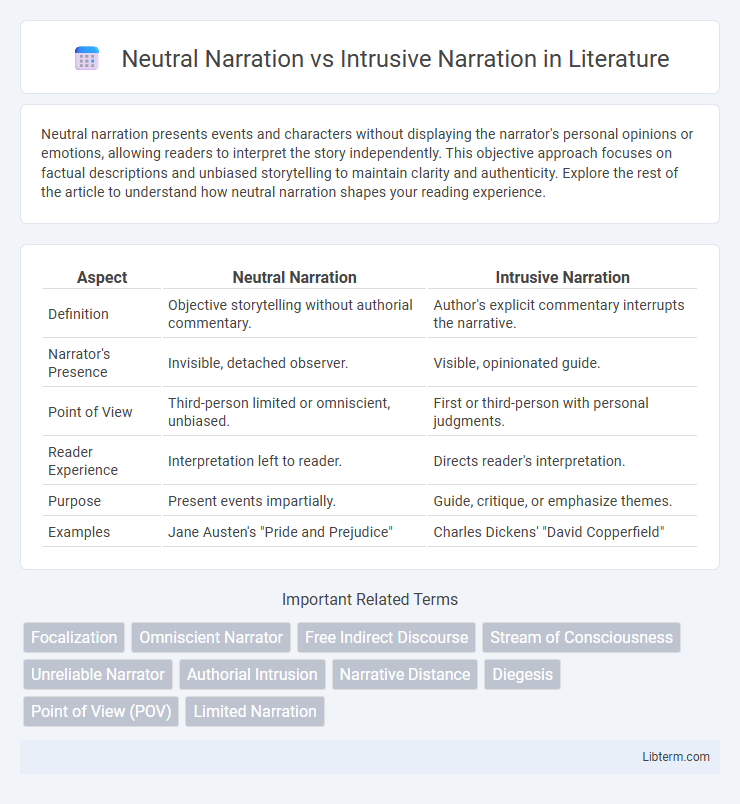Neutral narration presents events and characters without displaying the narrator's personal opinions or emotions, allowing readers to interpret the story independently. This objective approach focuses on factual descriptions and unbiased storytelling to maintain clarity and authenticity. Explore the rest of the article to understand how neutral narration shapes your reading experience.
Table of Comparison
| Aspect | Neutral Narration | Intrusive Narration |
|---|---|---|
| Definition | Objective storytelling without authorial commentary. | Author's explicit commentary interrupts the narrative. |
| Narrator's Presence | Invisible, detached observer. | Visible, opinionated guide. |
| Point of View | Third-person limited or omniscient, unbiased. | First or third-person with personal judgments. |
| Reader Experience | Interpretation left to reader. | Directs reader's interpretation. |
| Purpose | Present events impartially. | Guide, critique, or emphasize themes. |
| Examples | Jane Austen's "Pride and Prejudice" | Charles Dickens' "David Copperfield" |
Understanding Neutral Narration
Neutral narration presents the story with an objective voice, avoiding authorial interruptions or explicit commentary, allowing readers to interpret events and characters independently. This technique enhances immersion by maintaining narrative distance and fostering unbiased engagement with the plot. Understanding neutral narration requires recognizing its role in delivering a straightforward, transparent account that prioritizes showing over telling.
Defining Intrusive Narration
Intrusive narration occurs when the narrator breaks the story's flow to directly address the reader, offering opinions, commentary, or explanations that influence interpretation. Unlike neutral narration, which maintains an objective and unbiased perspective, intrusive narration actively shapes the reader's understanding through subjective insights. This narrative style is often employed in classic literature and metafiction to create a conversational or self-aware storytelling experience.
Key Differences Between Narrative Styles
Neutral narration provides an unbiased, objective account of events, allowing readers to interpret the story without authorial influence, while intrusive narration involves the narrator directly addressing the audience, offering commentary, opinions, or insights that guide interpretation. Neutral narration emphasizes showing rather than telling, often employing limited or omniscient viewpoints without editorial interventions. Intrusive narration breaks the narrative boundary by inserting the narrator's voice, shaping tone, mood, and reader perception through explicit authorial presence.
Effects on Reader Engagement
Neutral narration fosters immersive reader engagement by allowing audiences to form independent interpretations without authorial interference, enhancing emotional connection through subtlety. Intrusive narration guides readers' perceptions directly, increasing clarity and emphasizing themes but potentially reducing personal immersion. Balancing these narration styles can optimize reader involvement by combining interpretive freedom with narrative direction.
Neutral Narration in Classic Literature
Neutral narration in classic literature often employs an objective, detached tone that allows the story to unfold without the narrator's personal commentary or judgment, creating a sense of realism and impartiality. This style is evident in works like Jane Austen's novels, where the narrator presents characters and events with subtle irony or gentle skepticism but avoids overt intervention. By maintaining narrative distance, neutral narration enables readers to interpret characters' actions and motivations independently, fostering deeper engagement with the text.
Impact of Intrusive Narration on Storytelling
Intrusive narration directly addresses the reader, influencing audience perception by guiding interpretation and introducing authorial commentary, which can create a layer of complexity or bias within the narrative. This technique disrupts narrative immersion, prompting readers to critically engage with the story's themes and characters rather than passively consuming the plot. The impact of intrusive narration enhances thematic depth and authorial presence, distinguishing it from neutral narration's objective and detached storytelling style.
Authorial Voice and Narrative Presence
Neutral narration minimizes authorial voice and narrative presence, allowing the story and characters to unfold without overt commentary or judgment. Intrusive narration features a strong authorial voice that directly addresses readers, often offering opinions, explanations, or reflections that shape the interpretation of the narrative. The contrast hinges on how prominently the narrator intervenes in the storytelling, influencing reader engagement and perspective.
Choosing the Right Narration for Your Story
Choosing the right narration style for your story greatly impacts reader engagement and tone; neutral narration offers an objective, unobtrusive perspective that allows readers to interpret events independently, whereas intrusive narration provides commentary and authorial insight, shaping the reader's understanding more directly. A neutral narrator preserves narrative ambiguity and encourages personal interpretation, making it ideal for complex plots or multifaceted characters. Intrusive narration suits stories requiring moral guidance or thematic emphasis, as the narrator's presence clarifies intent and deepens emotional resonance.
Common Pitfalls in Narrative Approach
Neutral narration often falls into the pitfall of emotional detachment, causing readers to disengage due to lack of character insight or vivid detail. Intrusive narration can overwhelm the narrative with the author's opinions or commentary, disrupting immersive storytelling and breaking the reader's connection with the plot. Balancing these approaches requires careful control over the narrator's presence to maintain clarity and reader engagement without sacrificing depth or perspective.
Trends in Modern Narrative Techniques
Neutral narration in modern narratives emphasizes an unbiased, objective perspective, allowing readers to interpret events without authorial judgment. Intrusive narration, characterized by the narrator's commentary and subjective insights, has seen a decline as contemporary trends favor immersive, character-driven storytelling. The shift reflects a broader movement towards realism and subtlety in narrative techniques, prioritizing reader engagement over overt narrative control.
Neutral Narration Infographic

 libterm.com
libterm.com